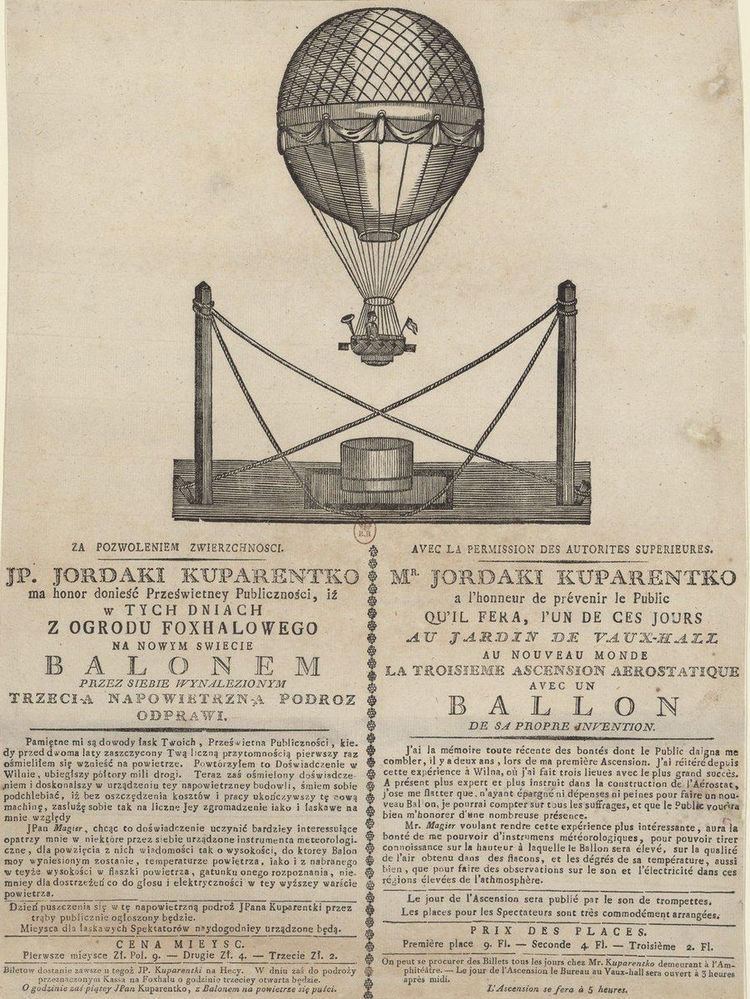Name Jordaki Kuparenko | ||
 | ||
Iordache Cuparencu (born 1784, Iaşi - died 1844, Warsaw) was a circus artist, aeronautics pioneer and engineer of Moldavian-Romanian descent and Polish citizenship.
Contents
Early life
Iordache Cuparencu, (Cuparentco, in the Polish newspapers: Jordaki Kuparentko/Kupareńko, or as in his autographs - Kuparenko) was born in 1784 in the vicinity of Iasi into a wealthy family. According to Orgelbrand's Encyclopedia (1864), because of being bullied by his brothers, he left his family in 1798, hiring as a decorator artist at the theatre in Iasi. Around 1800, he joined J. Kolter's French traveling circus, that was displaying in Moldavia at the time. During the tour he fallen in love with the owner's daughter, which he married in 1804. Cuparencu become a co-owner of the athletes' troupe, although the couple divorced in 1808. While he toured in Poland, he fallen from a height during a tightrope show and broke his leg severely. It turned out to be the end of his professional career as a stunt and tied him with Warsaw for the rest of his life, although he was active entrepreneur of the circus later on.
Engineering career
Soon after a partial recovery from the accident, Cuparencu found his new venture, engineering, and experimented with constructing and piloting hot air balloons, being inspired by successes heard from abroad. With the first two of his designs being made part of paper, he publicly flew three times, from 1806 to 1808, over Warsaw and Vilnius, taking public interest. Despite some dangerous accidents, flights were a commercial success (as it gained full audiences) and acknowledged him as an inventor. In fact, after the very first public take-up in June, the balloon burst in fire at the height of a church tower, and he saved his life using vents fast enough, landing safely in the Krakowskie Przedmiescie. The second flight in the 6 December (the same year) in Vilnius, using the same type of a construction, was safe (despite strong wind) and gave a "high altitude" and a distance of 1,5 "miles" long (which could be up to 13 km, if interpreted as contemporary polish mile). During his third flight in 1808, 24 July, which started at 8 p.m., he used a new, fully fledged construction "without cutting of expenses and work", as he described in his poster. Although ticketed, the flight was also of scientific nature, and he carried out some meteorological measurements, with equipment being delivered by professor A. Mager from Warsaw. The experiment showed 3882 French feet (1320 meters) height and the temperature of "few [Celsius] degrees" (as it was corresponded), "so the observer [Mr. Cuparencu] felt cold", while the temperature of air near ground was reported 23 Celsius degrees. Sample of air was planned to be taken (as announced in the poster seen in the right). The flight was successful but also featured an emergency landing, as the balloon started to torn apart because of a sudden, strong wind from the upper heights, "few minutes" after good conditions that enabled the data being collected. It then began to fall down and eventually ignited near ground. Despite that Cuparencu, holding firmly the chimney, did not leave the gallery and landed safely on sands near the Warsaw Powązki cemetery, after the flight taking "less than 15 min", "with the fired-up chimney and the bottom of the gallery serving as a parachute". He was helped then by "Two French" bystanders and transported in good health to the city, to the excited and relieved audience. Cuparencu and the incidents are listed in Guinness World Records list of aircraft, as the first survivor of air crash and first successful usage of a parachute in action ever.
Puppeteer theater and other activities
One of the great interests of Cuparencu was, connected to his motherland, the art of puppeteering. From 1816 he has been known as theater owner and manager, founding his headquarters for 4 times in different places over the Warsaw (one of them being National Theater's chambers). The first of his works was shadow plays (which was first of this kind in Warsaw). Since then he has constructed and managed a mechanized puppet theater (named Pitoresque), which officially started 1830 (upgraded in 1842), and was well received in the city, so it was even exhibited in Paris. It also featured optical-mechanical illusions, where the visitor could witness dioramas and panoramic "pictures of diverse places". According to a 19th-century encyclopedia, "sunsets, sun in the midday, sundowns and nights were being witnessed with all the illusion", accompanied by realistic sound effects, such as thunder or rain.
Cuparencu was also a Polish army soldier since 1811, getting to rank of the lieutenant (of the artillery), as he spend the rest of his life in Poland. Some of his other inventions are:
In 1808 he married for the second time with Anna Henrtietta Teiflin, the daughter of Heca amphitheater owner, which he has been managing since, and which he eventually bought in 1821. His biography is listed in the first edition of Polish encyclopedia by Samuel Orgelbrand. Iordache Cuparencu is buried at the Orthodox Cemetery in Warsaw.
